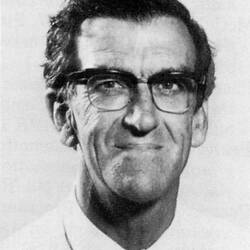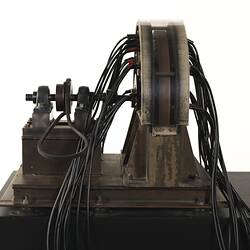Summary
This drum iwas intended to replace the original drum operational with CSIR Mk 1 in Sydney. The drum has 30 heads, but was most likely of the same memory capacity as the operational drum ie. 1024, 20 bit words. It was never finished and never actually used with CSIRAC.
When CSIR Mk1 (later CSIRAC) began operating, it only had a mercury delay line storage system. In 1950, work began on the development of an auxiliary store in the form of a magnetic drum to provide additional data storage capacity. It was completed and trialled by 1952. The development of the drum was the responsibily of Brian Cooper. Once the drum storage was running, Trevor Pearcey, one of CSIRAC's two designers, requested that another drum be constructed with quadruple the storage capacity.This project reached an advanced stage but was not completed. Instead, a disk storage was developed in Sydney and fitted to the computer after it was transferred from Sydney to Melbourne
More Information
-
Collection Names
-
Collecting Areas
-
Acquisition Information
Donation from Commonwealth Scientific & Industrial Research Organisation (CSIRO), Frank Hirst - University of Melbourne (The), Mar 1965
-
Commissioned By
Commonwealth Scientific & Industrial Research Organisation (CSIRO), Sydney, Greater Sydney, New South Wales, Australia, 1950-1954
-
Classification
-
Category
-
Discipline
-
Type of item
-
Overall Dimensions
30 cm (Length), 28 cm (Width), 23 cm (Height), 12 kg (Weight)
INCLUDES 3 CABLES L 118CM, DIAMETRE 2.5CM
-
Exhibition Collection Management
300 mm (Length), 280 mm (Width), 230 mm (Height), 12 (Weight)
3 attached cords - 1170mm long
-
Dimensions
19.5 cm (Length), 25.3 cm (Width), 22.5 cm (Height)
Measurement From Conservation. Measuring Method: cables 1.21m, conservation only
-
References
[Book] McCann, Doug & Thorne, Peter. 2000. The Last of the First CSIRAC: Australia's First Computer. 196., 2000, 3, 34 - 35 Pages
-
Keywords
Computers, Computing, CSIRAC (Computer), Making History - CSIRAC


